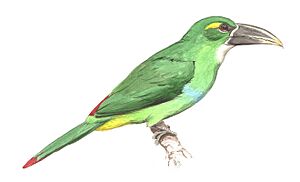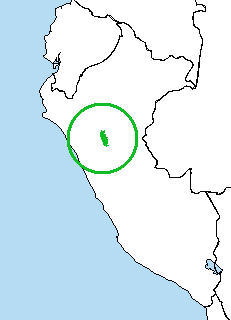Yellow-browed toucanet facts for kids
Quick facts for kids Yellow-browed toucanet |
|
|---|---|
 |
|
| Conservation status | |
| Scientific classification | |
| Genus: |
Aulacorhynchus
|
| Species: |
huallagae
|
 |
|
| Range of A. huallagae in Peru | |
The yellow-browed toucanet (Aulacorhynchus huallagae) is a special bird. It lives only in the country of Peru. This colorful bird is part of the toucan family, known for their big, bright bills. Sadly, it is an Endangered species. This means it needs our help to survive in the wild.
Contents
What Does the Yellow-browed Toucanet Look Like?
This toucanet is about 38 to 44 centimeters (15 to 17 inches) long. That's roughly the length of a school ruler! It weighs around 250 to 280 grams (9 to 10 ounces). Both male and female toucanets look exactly the same.
Their bill is mostly bluish-gray with a white tip. It also has a bright white band near its base. Their bodies are mostly yellowish-green. The top of their head is a purer green color.
Their face and the sides of their neck are apple green. They have a short, narrow yellow stripe above their eye. This stripe is called a supercilium. Around their reddish eye, their skin is bare and black.
Their throat is whitish. This color changes to greener shades down to a bright blue band across their lower chest. Their belly and sides are yellowish-green. The feathers under their tail are golden yellow.
The top of their tail is green. The two feathers in the middle have a blue tint. The two innermost pairs of tail feathers have chestnut-colored tips. The underside of their tail is a dusky bluish color.
Where Does the Yellow-browed Toucanet Live?
The yellow-browed toucanet lives in a very small area. This area is on the eastern side of the northern Andes mountains in Peru. Scientists have only found it in a few specific places. These include one spot in the southern Amazonas Department. They also live in two places in the San Martín Department. One more location is in the northeastern La Libertad Department.
It probably lives in the areas between these known spots too. It might even live further north and south. However, these areas have no roads, making them very hard to explore. This makes it difficult for scientists to find new groups of these birds.
This toucanet makes its home in humid montane forest. These are forests found high up in the mountains. It lives at elevations between 2,000 and 2,600 meters (6,560 and 8,530 feet).
How Does the Yellow-browed Toucanet Live?
Feeding Habits
The yellow-browed toucanet mostly looks for food high up in the treetops. This area is called the canopy. We know it eats fruit. However, scientists do not have many details about what else it eats.
Reproduction and Life Cycle
Scientists know very little about how the yellow-browed toucanet raises its young. Its nesting season seems to be from October to February or March. Like other toucans in its family, it is thought to nest in holes found in trees.
What Sounds Does It Make?
The yellow-browed toucanet has a unique call. Some people describe it as a series of 20 to 30 frog-like "krik" notes. Others say it sounds like a series of harsh grunts, like "rehh rehh rehh..."
What Is the Yellow-browed Toucanet's Status?
The IUCN is an organization that studies endangered species. They first listed the yellow-browed toucanet as "Threatened." But since 2000, they have called it "Endangered."
The biggest danger to this bird is that its forest home is being cut down. People are clearing the land for farming. Most of this forest clearing has happened at lower elevations.
Scientists believe that the number of people living in this bird's range was higher in the past. The yellow-browed toucanet is probably the least-known toucan. Scientists think it might live in more places than we currently know. They believe it could be less endangered than it seems.


